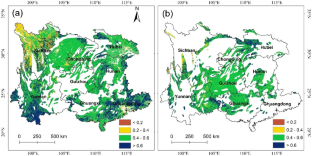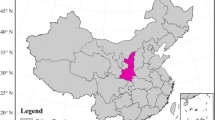Abstract
The karst region of Southwest China is one of the largest in the world. Due to the effects of human activities and climate change, rocky desertification has become the primary ecological disaster which has significantly hindered the economic growth in Southwest China. In recent decades, the Chinese government has carried out a number of ecological restoration projects in Southwest China. This study aims to analyze the changes in vegetation coverage and its main driving factors in the Southwest China and the karst region of Southwest China from 2001 to 2015 through trend analysis, Hurst index correlation analysis, correlation analysis, and residual analysis. The results showed that (1) both Southwest China and the karst region of Southwest China experienced significant increasing trends in annual fractional vegetation cover, at a rate of 0.0028 year−1 and 0.0029 year−1, respectively; (2) the NDVI of the Southwest China and the karst region of Southwest China was stable, and the vegetation coverage areas showed low to medium fluctuations, accounting for 97.17% and 98.32% respectively; (3) the NDVI of the Southwest China and the karst region of Southwest China had strong sustainability, and the sustainable and improved regions account for 74.79% and 75.77% respectively; and (4) climate change had little influence on vegetation restoration, and human activities had a great influence on vegetation restoration. The relative contribution rates of human activities and climate change to vegetation NDVI changes in the Southwest China were 86% and 14%, respectively, and 90% and 10% in karst regions of Southwest China. Our findings contribute to a better understanding of the mechanisms of vegetation change in karst region and may provide scientific support for local vegetation restoration and conservation policies.










Similar content being viewed by others

Explore related subjects
Discover the latest articles, news and stories from top researchers in related subjects.Data availability
The datasets used and/or analyzed during the current study are available from the corresponding author on reasonable request.
References
Barriopedro D, Gouveia CM, Trigo RM, Wang L (2012) The 2009/10 Drought in China: possible causes and impacts on vegetation. J Hydrometeorol 13:1251–1267. https://doi.org/10.1175/jhm-d-11-074.1
Cai H, Yang X, Wang K, Xiao L (2014) Is forest restoration in the Southwest China karst promoted mainly by climate change or human-induced factors? Remote Sens 6:9895–9910. https://doi.org/10.3390/rs6109895
Cao JH, Yuan DX, Tong LQ, Mallik A, Hui Y, Fen H (2015) An overview of karst ecosystem in Southwest China: current state and future management. J Resour Ecol 6:247–256. https://doi.org/10.5814/j.issn.1674-764x.2015.04.008
Chappell A, Webb NP, Guerschman JP, Thomas DT, Mata G, Handcock RN, Leys JF, Butler HJ (2018) Improving ground cover monitoring for wind erosion assessment using MODIS BRDF parameters. Remote Sens Environ 204:756–768. https://doi.org/10.1016/j.rse.2017.09.026
de Jong R, de Bruin S, de Wit A, Schaepman ME, Dent DL (2011) Analysis of monotonic greening and browning trends from global NDVI time-series. Remote Sens Environ 115:692–702. https://doi.org/10.1016/j.rse.2010.10.011
Ji L, Peters AJ (2010) A spatial regression procedure for evaluating the relationship between AVHRR-NDVI and climate in the northern Great Plains. Int J Remote Sens 25:297–311. https://doi.org/10.1080/0143116031000102548
Jiang Z, Lian YQ, Qin XQ (2014) Rocky desertification in Southwest China: impacts, causes, and restoration. Earth Sci Rev 132:1–12 https://doi.org/10.1016/j.earscirev.2014.01.005
Jiang W, Yuan L, Wang W, Cao R, Zhang Y, Shen W (2015) Spatio-temporal analysis of vegetation variation in the Yellow River Basin. Ecol Indic 51:117–126. https://doi.org/10.1016/j.ecolind.2014.07.031
Jiang M, Lin Y, Chan TO, Yao Y, Zheng G, Luo S et al (2020) Geologic factors leadingly drawing the macroecological pattern of rocky desertification in southwest China. Sci Rep 10:1–11. https://doi.org/10.1038/s41598-020-58550-1
Li R, Wu Q, Zhang J, Wen Y, Li Q (2019) Effects of land use change of sloping farmland on characteristic of soil erosion resistance in typical karst mountainous areas of southwestern China. Polish J Environ Stud 28:2707–2716. https://doi.org/10.15244/pjoes/94288
Liu R, Liu Y, Jiyuan L (2009) Research progress of MODIS scientific data processing. Prog Nat Sci 19:141–147
Liu S, Dong H, An N, Wang J, Zhao H (2014) Dynamics of salinization land based on EVI series data and landscape pattern analysis in Songnen Plain: a case study in Da’an City. Chin J Appl Ecol 25:3263–3269. https://doi.org/10.13287/j.1001-9332.20140918.017
Liu Q, Wang X, Zhang Y, Zhang H, Li L (2019) Vegetation degradation and its driving factors in the farming–pastoral ecotone over the countries along Belt and Road Initiative. Sustainability. 11. https://doi.org/10.3390/su11061590
Liu H, Jiao F, Yin J, Li T, Gong H, Wang Z, Lin Z (2020) Nonlinear relationship of vegetation greening with nature and human factors and its forecast – a case study of Southwest China. Ecol Indic 111:106009. https://doi.org/10.1016/j.ecolind.2019.106009
Milich L, Weiss E (2010) GAC NDVI interannual coefficient of variation (CoV) images: ground truth sampling of the Sahel along north-south transects. Int J Remote Sens 21:235–260. https://doi.org/10.1080/014311600210812
Pei J, Wang L, Wang X, Niu Z, Kelly M, Song X-P, Huang N, Geng J, Tian H, Yu Y, Xu S, Wang L, Ying Q, Cao J (2019) Time series of Landsat imagery shows vegetation recovery in two fragile karst watersheds in southwest China from 1988 to 2016. Remote Sens 11. https://doi.org/10.3390/rs11172044
Piao S, Yin G, Tan J, Cheng L, Huang M, Li Y, Liu R, Mao J, Myneni RB, Peng S, Poulter B, Shi X, Xiao Z, Zeng N, Zeng ZZ, Wang Y (2015) Detection and attribution of vegetation greening trend in China over the last 30 years. Glob Chang Biol 21:1601–1609. https://doi.org/10.1111/gcb.12795
Qian D, Cao G, Du Y, Li Q, Guo X (2019) Impacts of climate change and human factors on land cover change in inland mountain protected areas: a case study of the Qilian Mountain National Nature Reserve in China. Environ Monit Assess 191:486. https://doi.org/10.1007/s10661-019-7619-5
Roerink GJ, Menenti M, Soepboer W, Su Z (2003) Assessment of climate impact on vegetation dynamics by using remote sensing. Phys Chem Earth 28:103–109. https://doi.org/10.1016/s1474-7065(03)00011-1
Sánchez Granero MA, Trinidad Segovia JE, García PJ (2008) Some comments on Hurst exponent and the long memory processes on capital markets. Physica A 387:5543–5551. https://doi.org/10.1016/j.physa.2008.05.053
Sheng R, Wan L (2019) Evolution of vegetation coverage and its response to abrupt climate change in the Wuyi Mountains National Nature Reserve. Acta Ecol Sin 39:3243–3256. https://doi.org/10.5846/stxb201801310264
Shi K, Yang Q, Li Y (2019) Are karst rocky desertification areas affected by increasing human activity in southern China? An empirical analysis from nighttime light data. Int J Environ Res Public Health 16. https://doi.org/10.3390/ijerph16214175
Song L, Li Y, Ren Y, Wu X, Guo B, Tang X, Shi W, Ma M, Han X, Zhao L (2019) Divergent vegetation responses to extreme spring and summer droughts in Southwestern China. Agric For Meteorol 279:107703. https://doi.org/10.1016/j.agrformet.2019.107703
Tao J, Xu T, Dong J, Yu X, Jiang Y, Zhang Y, Huang K, Zhu J, Dong J, Xu Y, Wang S (2018) Elevation-dependent effects of climate change on vegetation greenness in the high mountains of southwest China during 1982-2013. Int J Climatol 38:2029–2038. https://doi.org/10.1002/joc.5314
Tong X, Wang K, Brandt M, Yue Y, Liao C, Fensholt R (2016) Assessing future vegetation trends and restoration prospects in the karst regions of southwest China. Remote Sens 357. https://doi.org/10.3390/rs8050357
Tong X, Wang K, Yue Y, Brandt M, Liu B, Zhang C, Liao C, Fensholt R (2017) Quantifying the effectiveness of ecological restoration projects on long-term vegetation dynamics in the karst regions of Southwest China. Int J Appl Earth Obs Geoinf 54:105–113. https://doi.org/10.1016/j.jag.2016.09.013
Wang J, Wang K, Zhang M, Zhang C (2015) Impacts of climate change and human activities on vegetation cover in hilly southern China. Ecol Eng 81:451–461. https://doi.org/10.1016/j.ecoleng.2015.04.022
Xiao K, Tang J, Chen H, Li D, Liu Y (2020) Impact of land use/land cover change on the topsoil selenium concentration and its potential bioavailability in a karst area of southwest China. Sci Total Environ 708:135201. https://doi.org/10.1016/j.scitotenv.2019.135201
Yan YJ, Dai QH, Wang XD, Jin L, Mei LN (2019) Response of shallow karst fissure soil quality to secondary succession in a degraded karst area of southwestern China. Geoderma. 348:76–85. https://doi.org/10.1016/j.geoderma.2019.04.017
Yuan D (2008) The global vision of karst rocky desertification problem and the countermeasures and experience of our country. Pratacultural Sci 25:19–25
Zhang M, Wang K, Liu H, Zhang C, Yue Y, Qi X (2018) Effect of ecological engineering projects on ecosystem services in a karst region: a case study of northwest Guangxi, China. J Clean Prod 183:831–842. https://doi.org/10.1016/j.jclepro.2018.02.102
Zhang Z, Huang X, Zhou Y, Zhang J, Zhang X (2019) Discrepancies in karst soil organic carbon in southwest China for different land use patterns: a case study of Guizhou Province. Int J Environ Res Public Health 16. https://doi.org/10.3390/ijerph16214199
Zhang X, Yue Y, Tong X, Wang K, Qi X, Deng C, Brandt M (2021) Eco-engineering controls vegetation trends in southwest China karst. Sci Total Environ 770:145160. https://doi.org/10.1016/j.scitotenv.2021.145160
Zhao S, Pereira P, Wu X, Zhou J, Cao J, Zhang W (2020) Global karst vegetation regime and its response to climate change and human activities. Ecol Indic 113:106208. https://doi.org/10.1016/j.ecolind.2020.106208
Zhao S, Wu X, Zhou J, Pereira P (2021) Spatiotemporal tradeoffs and synergies in vegetation vitality and poverty transition in rocky desertification area. Sci Total Environ 752:1–13. https://doi.org/10.1016/j.scitotenv.2020.141770
Zhou L, Wang X, Wang Z, Zhang X, Chen C, Liu H (2020a) The challenge of soil loss control and vegetation restoration in the karst area of southwestern China. Int Soil Water Conserv Res 8:26–34. https://doi.org/10.1016/j.iswcr.2019.12.001
Zhou Y, Li Y, Liu Y (2020b) The nexus between regional eco-environmental degradation and rural impoverishment in China. Habitat Int 96:102086. https://doi.org/10.1016/j.habitatint.2019.102086
Funding
This work was supported by the Key Research and Development Program of Guangxi (AB18050014), the National Natural Science Foundation of China (Grant No. 41701391), the Beijing Natural Science Foundation (8192037), and the Fundamental Research Funds for the Central Universities (Grant No. 2014QD02).
Author information
Authors and Affiliations
Contributions
W Chen: methodology. S Bai: coding, writing, and formal analysis. L Li: editing. H Zhao: editing. X Han: resources.
Corresponding author
Ethics declarations
Ethics approval and consent to participate
Not applicable
Consent for publication
Not applicable
Competing interests
The authors declare no competing interests.
Additional information
Responsible Editor: Philippe Garrigues
Publisher’s note
Springer Nature remains neutral with regard to jurisdictional claims in published maps and institutional affiliations.
Submitted for publication in Environmental Science and Pollution Research
Rights and permissions
About this article
Cite this article
Chen, W., Bai, S., Zhao, H. et al. Spatiotemporal analysis and potential impact factors of vegetation variation in the karst region of Southwest China. Environ Sci Pollut Res 28, 61258–61273 (2021). https://doi.org/10.1007/s11356-021-14988-y
Received:
Accepted:
Published:
Issue Date:
DOI: https://doi.org/10.1007/s11356-021-14988-y


